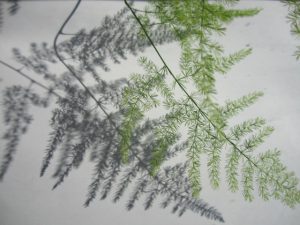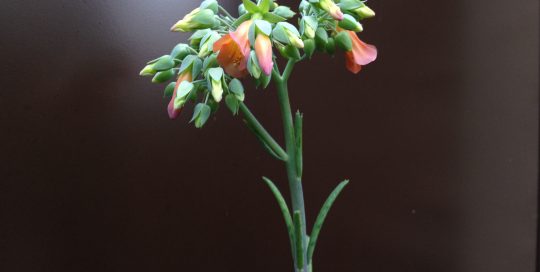Asparagus Ferns Gone Wild
Views: 7714

I don’t remember where I acquired my Asparagus fern. I can guarantee it was a free plant, a cast away from some job. Because I have a hard time tossing live, usable plants into the compost pile, I have acquired many plants this way.
I’m never sure that I really want them, and I’ll often try to toss them out, but then I feel guilty about the death sentence I’m imposing and bring them home instead. It’s becoming a problem.
Anyways, back to the Asparagus fern. For years I kept it in the living room, which gets little light from a north-facing window. It survived these conditions, but it definitely was not thriving. So I decided to sacrifice some more of my desk space to plants. I’ve moved the Asparagus fern into the office, which has an east-facing window. It started growing like it’s on a quest for world domination. Suddenly there are stems clambering up and down the wall around the window and some of them are five feet long! The right light makes all the difference.
Types of Asparagus Ferns
Asparagus ferns are not true ferns and actually belong to the Lily family, Liliaceae. Mine is technically called Protasparagus setaceus (see picture). It’s is the type most commonly used in floral arrangements, with flat lacy fronds full of tiny soft needles.
There are two other types more commonly found in nurseries, Sprenger’s (Protasparagus densiflorus ‘Sprengeri’) and Foxtail (Protasparagus densiflorus ‘Meyeri’). Both of these are most commonly available for sale alongside annual flowers because they add great texture to mixed container plantings. Foxtail ferns are also very nice in a pot or hanging basket by themselves.
Both Sprenger’s and Foxtail ferns root aggressively and create large rhizomes. The florist’s Asparagus fern does not, meaning it won’t need to be repotted as often. All of them are easy keepers, adapting well to most light conditions besides direct all-day sun, and are forgiving of both over- and under-watering.
Keep Them Under Control
If your Asparagus fern gets out of hand or has a yellowing frond, it’s best to remove the whole stem by cutting it down at the base.
Be careful when handling the stems—they have small (but sharp!) thorns. Asparagus ferns also be divided into multiple plants by cutting the root ball into two or more sections.
Asparagus ferns are hardy in Zone 8 or higher and are considered a noxious weed in some areas. Be careful not to let your plant spread if you live in these areas. I think I’m just going to let mine grow and see what happens. Apparently stems can get up to ten feet long. So if you don’t see another post from me soon, my Asparagus vine may have eaten me.
Meet Abbi Hayes
Abbi's Recent Posts

Kalanchoe delagoensis: Mother of Millions







